Apparently clicking on embedded links is to onerous a task for some of my busier readers. So as opposed to linking inspirational images and summaries of the games and campaign worlds in question I’ll try and briefly outline why Im interested in running the various campaign ideas in my previous post (and what kind of commitment, nay burden, I expect potential players to undertake).
Note: Well its now far too late for me to be up, I think Ive covered everything (if at least briefly) below and in the previous post. If you have any questions or comments, feel free to ask them below (even just so Ill know if the comments function works).
D&D 4th Edition
Firstly I’d like you to note the “4th Edition” part of the title. Its a whole new edition and quite radically different rules wise from the previous ones. I did run a (super) short (i.e. one session) mini-campaign for it. But to be honest the adventure was terrible and the encounters/setup was fairly stolid. So I wouldnt let that sour you on the experience. Why Im excited to try out D&D 4th Edition?
- A strong focus – D&D 4th Edition knows the kind of game it should be used to run and sets out to support that type of game. Its about heroic action fantasy adventure and it enforces this focus in both fluff and rules.
- Excellent balance – each character is equally effective so everyone is mechanically guranteed their time in the spotlight. Each character has a mechanical niche they fulfill and as such they wont be supplanted by a better designed or optimised character (e.g. your sword and board gladiator will have something different and equally effective to do as my nimble duelist)
- Easy to prep for, easy to run – 4th edition is remarkably easy to prep for, requiring little time beyond coming up with the plot. It has an excellent ratio of GM Time:Play Time, compared to both its predecessors and other mainline rpgs. Its made even easier by the excellent suite of digital tools available. The Character Builder is useful to both players and GM’s, the Compendium and the Adventure Tools suite make adventure creation a breeze (even more so if I use Masterplan).
- Tactical miniatures combat – While you could possibly play it without miniatures the game certainly has a strong mechanical focus on tactical miniatures combat. FUN, tactical minitaures combat. It runs like a very smooth verion of any good JSRPG e.g. Disgaea. Im not going to bust out the battlemat for taking down a few brigands or such. But one or two big combats and a nice set piece battle are something Im interested in doing more or less each session. While combat might take slightly longer than in some games (and to be honest I cant think of any game where combat is particularly fast) its more than made up for by the fact that the combat is more enjoyable for all involved.
- System support for role-playing: While their initial implementation was rocky the skill challenge system provides an excellent framing mechanism for roleplay as well as a great reward system that encourages innovation. Basically non-combat is integrated into the reward system, and skill challenges provide a low-level but persistent incentive to roleplay
- Excllent GM’ing Advice – Not someting that really comes into play session to session but DMG 1 & 2 contain better DMing advice than any other book’s Ive read.
- The “Classic Campaign” – Starting characters out at level one and running them all the way to maximum level (in this case 30). In older versions of D&D there were huge problems with doing this, ranging from different advancement rates to the irrelevance of non-magic using characters in the mid to late game. But 4th edition is equally balanced (and from a DM’ing POV, equally supported) across all three tiers (1-10:Heroic, 11-20:Paragon, 21-30:Epic) of play. Characters also only get minimally more complex between first and thirtieth level, which doesnt leave people floundering trying to figure out what they can do.
- Well differentiated levels of play, the three tiered system of play makes it easy to plot out your entire campaign in broad story arcs as you have a fairly accurate idea of what kind of power level your players will be at certain points in time (even if you dont know what exactly theyll be up to). This allows you to build a campaign structure around real world scheduling issues (if I get this off the ground it will consist of three major story arcs, each split into two smaller arcs which will take 4-5 sessions (and raise people 4-5 levels) to complete)
Dark Sun
I wouldnt want my readers to risk RSI from clicking on a link so I’ll just copy and paste Wotc’s executive summary of Dark Sun 4th Edition. On a personal level Dark Sun appeals because Im interested in:
- A world with no clearly defined morals,where the good guys are good only because theyre better than the worse, where the heroes are as harsh as the climate and are cast more in the mold of classical heroes (http://en.wikipedia.org/wiki/Epic_hero)
- Psionics have a prominent role and I really like psionics. Even more so in 4th edition where the system is both simple and flavourful
- Classic sword and sandals action. A grim wasted world where hard heroes fight strange monsters and evil sorcerers. It harks back to classic pulp fantasy in the mold of Conan, Lankhmar, The Eternal Champion, etc.
- Only one Dragon, which makes its inclusion and possible defeat suitably epic.
- Weird ass creatures, e.g. the pain bettle, a beetle about an inch long which crawls under peoples clothes and uses its numbing bite to burrow into their spine, where it tortures them and feeds on the pain.
- The awesome and cohesive visuals Brom put together for the first game e.g.


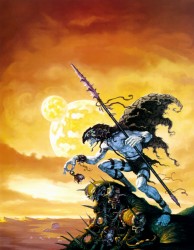
Eight Characteristics of Athas
The world of the Dark Sun setting is unique in several ways. Many familiar trappings of the Dungeons & Dragons game are missing or turned on their heads. Athas is not a place of shining knights and robed wizards, of deep forests and divine pantheons. To venture over the sands of Athas is to enter a world of savagery and splendor that draws on different traditions of fantasy and storytelling. Simple survival beneath the deep red sun is often its own adventure.
Newcomers to Athas have much to learn about the world, its people, and its monsters, but the following eight characteristics encapsulate the most important features of the Dark Sun campaign setting.
1. The World Is a Desert
Athas is a hot, arid planet covered with endless seas of dunes, lifeless salt flats, stony wastes, rocky badlands, thorny scrublands, and worse. From the first moments of dawn, the crimson sun beats down from an olive-tinged sky. Temperatures routinely exceed 100 degrees F. by midmorning and can reach 130 degrees or more by late afternoon. The wind is like the blast of a furnace, offering no relief from the oppressive heat. Dust and sand borne on the breeze coat everything with yellow-orange silt.
In this forbidding world, cities and villages exist only in a few oases or verdant plains. Some places don’t see rain for years at a time, and even in fertile regions, rain is little more than a humid mist that falls during a few weeks each year before giving way to long months of heat and drought. The world beyond these islands of civilization is a wasteland roamed by nomads, raiders, and hungry monsters.
Athas was not always a desert, and the parched landscape is dotted with the crumbling ruins of a planet that once was rich with rivers and seas. Ancient bridges over dry watercourses and empty stone quays that face seas of sand tell the tale of a world that is no more.
2. The World Is Savage
Life on Athas is brutal and short. Bloodthirsty raiders, greedy slavers, and hordes of inhuman savages overrun the deserts and wastelands. The cities are little better; each chokes in the grip of an ageless tyrant. The institution of slavery is widespread on Athas, and many unfortunates spend their lives in chains, toiling for brutal taskmasters. Every year hundreds of slaves, perhaps thousands, are sent to their deaths in bloody arena spectacles. Charity, compassion, kindness—these qualities exist, but they are rare and precious. Only a fool hopes for such riches.
3. Metal Is Scarce
Most arms and armor are made of bone, stone, wood, and other such materials. Mail or plate armor exists only in the treasuries of the sorcerer-kings. Steel blades are almost priceless, weapons that many heroes never see during their lifetimes.
4. Arcane Magic Defiles the World
The reckless use of arcane magic during ancient wars reduced Athas to a wasteland. To cast an arcane spell, one must gather power from the living world nearby. Plants wither to black ash, crippling pain wracks animals and people, and the soil is sterilized; nothing can grow in that spot again. It is possible to cast spells with care, preserving the world and avoiding any more damage to it, but defiling offers more power than preserving. As a result, sorcerers, wizards, and other wielders of arcane magic are reviled and persecuted across Athas regardless of whether they preserve or defile. Only the most powerful spellcasters can wield arcane might without fear of reprisal.
5. Sorcerer-Kings Rule the City-States
Terrible defilers of immense power rule all but one of the city-states. These mighty spellcasters have held their thrones for centuries; no one alive remembers a time before the sorcerer-kings. Some claim to be gods, and some claim to serve gods. Some are brutal oppressors, where others are more subtle in their tyranny.
The sorcerer-kings govern through priesthoods or bureaucracies of greedy, ambitious templars, lesser defilers who can call upon the kings’ powers. Only in the city-state of Tyr does a glimmer of freedom beckon, and powerful forces already conspire to extinguish it.
6. The Gods Are Silent
Long ago, when the planet was green, the brutal might of the primordials overcame the gods. Today, Athas is a world without deities. There are no clerics, no paladins, and no prophets or religious orders. Old shrines and crumbling temples lie amid the ancient ruins, testimony to a time when the gods spoke to the people of Athas. Nothing is heard now but the sighing of the desert wind.
In the absence of divine influence, other powers have come to prominence in the world. Psionic power is well known and widely practiced on Athas; even unintelligent desert monsters can have deadly psionic abilities. Shamans and druids call upon the primal powers of the world, which are often sculpted by the influence of elemental power.
7. Fierce Monsters Roam the World
The desert planet has its own deadly ecology. Athas has no cattle, swine, or horses; instead, people tend flocks of erdlus, ride on kanks or crodlus, and draw wagons with inixes and mekillots. Wild creatures such as lions, bears, and wolves are nonexistent. In their place are terrors such as the id fiend, the baazrag, and the tembo. Perhaps the harsh environment of Athas breeds creatures tough and vicious enough to survive it, or maybe the touch of ancient sorcery poisoned the wellsprings of life and inflicted monster after monster on the dying world. Either way, the deserts are perilous, and only a fool or a lunatic travels them alone.
8. Familiar Races Aren’t What You Expect
Typical fantasy stereotypes don’t apply to Athasian heroes. In many Dungeons & Dragons settings, elves are wise, benevolent forest dwellers who guard their homelands from intrusions of evil. On Athas, elves are a nomadic race of herders, raiders, peddlers, and thieves. Halflings aren’t amiable riverfolk; they’re xenophobic headhunters and cannibals who hunt and kill trespassers in their mountain forests. Goliaths—or half-giants, as they are commonly known—are brutal mercenaries who serve as elite guards and enforcers for the sorcerer-kings and their templars in many city-states.
Anima
Anima is an interesting attempt at emulating JRPG style CRPG’s in tabletop form. While a lot of systems try and emulate the feel and setting of anime, manga and JRPG’s Anima is one of the few that trys to emulate the mechanics. In practice what this means is a median level of crunch with some really big numbers. What I find interesting about Anima is:
- The system: At its heart its a very simple percentile system. But each power source has its own massively customisable sub-system.
- The World: A nice pastiche of the kind of fantasy/tech mixups you see in series’ like Final Fantasy, anime like Steel Princess or manga like Ninja Scroll. The races and setup are extremely intriguing and to be honest ideas for campaigns basically write themselves. Im really looking forward to getting the setting book in the post in the next week or so.
- The Visuals: The main book is probably the most attractive RPG book I own (well Cthulhtech and Eclipse Phase give it a run for its money). The artists that work on the line are all exellent and their art really captures the feel of the world and game for me. Several of them have also worked on JRPG’s so that certainly helps. Ive included a sample (far too big a sample possibly) of some of the images below.
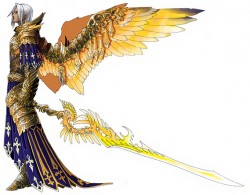
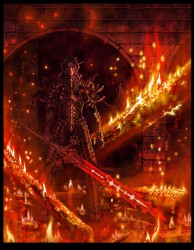

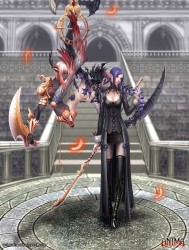
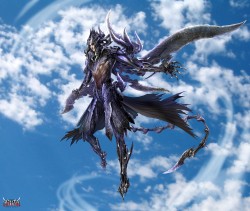

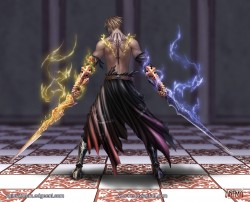

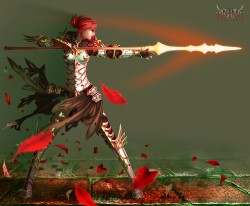



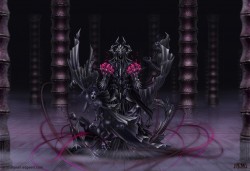



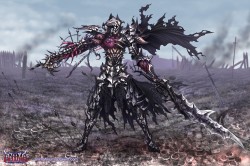
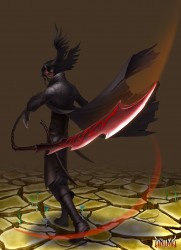
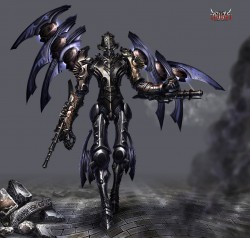

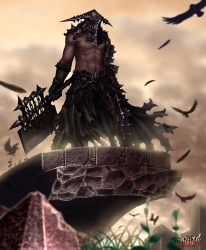
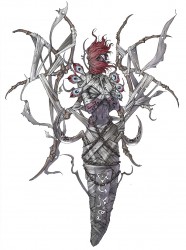
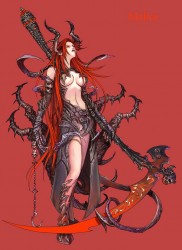

DC Adventures / Mutants and Masterminds 3rd Edition
Ive played in a few superhero games over the years, ran more and read even more. And one thing a lot of them have in common is that the systems are often prone to abuse, accidental or otherwise. Mutants and Masterminds was probably the most stable and well balanced superhero system I cam across, well thats not entirely true, HERO is probably more balanced. But M&M hit a sweet spot between balance and complexity that I found immensely appealing. I was really excited to run it and after coming up with my own spin on the marvel universe and some sample characters I did just that. And at the risk of tooting my own horn, that first session was excellent, everyone enjoyed it and it flowed very well. So looking back now it boggles me why when I went to run a campaign I didnt just continue it.
Instead I went with a WWII superhero campaign set in my own alt-history world. My first mistake with that campaign was in character generation, which happened individually and had no clear theme or structure (much like the campaign itself). We had basically unpowered and impotent agents hob-nobbing with guys who could bitch-slap Thor. This wasnt aided by my sudden desire to run things “by the book” without actually properly reading or following what was in the book (this lead to long drawn out fights where no-one could do anything but the same thing again and again). I suppose this would have been aided somewhat if more than one of the players had been even passingly familiar with the rules. But that didnt effect the “trial game” so Im thinking it was mostly my fault. The story was also a bit of a mess and I was expecting a bit more buy in from the players in terms of shared world creation – something that never seems to work. So unfortunately I think this experience soured most of the group on the system.
As such I never tried running anything with it again, so this new edition (DC Adventures is powered by M&M 3rd edition, soon to be published on its own) is a chance to re-introduce the game to the group (though now it strikes me that it will probably be all new players so this doesnt matter) and to a certain extent to myself. M&M 3rd edition is supposed to be a tighened up and streamlined version of 2nd, reducing some of the complexity and fixing some of the broken bits (fuck you in the ass grappling sub-system).
While Im not sure at the moment whether I’ll use the default DC Universe setting or not Im tempted to do so. Players seem to have an easier time buying into familiar properties, which is both the benefit and bane of a licensed games. The DC Universe has a slight edge here as its less publically accessible than the Marvel Universe. I also liked it less until a few years ago when I started reading the comics. Now theres some stuff I really like about it. So it lets me use a world the players are familiar with, but not so familiar that any changes I make will jar them too much.
For me Ive always wanted to run or play in a good long running superhero campaign, most of my favourite times as a player have been in superhero campaigns. Though Im not sure how much people are into it, if I was going to run a campaign I think I’d like to go with a neo-Silver Age thing ala Astro City (which everyone should read or borrow from me and read, because its excellent). I’d like to try and condense and convey the kind of things that I feel are the qunitessence of comics.
Eclipse Phase
The Setting is the best, and my favourite, thing about Eclipse Phase. I find the world incredibly appealing (even if possibly difficult to communicate to new players). The system, while not bad, is serviceable at best. Nothing really stands out, and while I personally love it, the character creation is both long and fairly complex. The rules themselves are simple enough but are at the higher end of medium crunch.
Legends of Anglerre / Starblazer Adventures
In stark contrast to Eclipse Phase, my favourite thing about these two games (LOA is basically an update and offshoot of Starblazer Adventures) is the system. I always found the FATE system intriguing but the versions that were previously available (e.g. Shadow of the Century) just didnt really do it for me. Then along came Starblazer Adventures with its rock and roll space opera aesthetic, something I was into at the time, and its new (and IMO improved) version of FATE and I was hooked. But theres simply too much in the book, the basic system is simple enough but they packed so much stuff in that the book is quite simply intimidating. Hardback, A4 and 660 pages makes it feel too much like an instruction manual (yes, yes thats basically what rpg’s are). So while I had some things I wanted to do with it I simply could never make it through the book.
Then along came Legends of Anglerre, a slimmed down and tightened up version of Starblazer Adventures version of FATE. And I was hooked again, but unfortunately the books publishing has been pushed back a few times and while I have the pre-order pdf I find it hard to read entire books on the computer (someone should buy me an iPad). But at some point in the next month or two I will most certainly run something using FATE.
I suppose I should describe why I find the system appealing, but its late and Im tired, so I’ll just copy and paste the summary from http://www.faterpg.com
“Fate is a free RPG system that focuses on telling stories and balancing characters based on story significance, rather than points and cool powers. It’s the system of choice for GMs who are looking for rules that get out of the way of the story, but still provide enough structure to get the job done.”
Listening to: DIO - Rainbow in the Dark
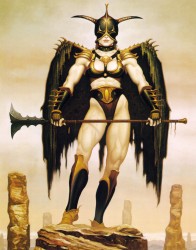


An excellent summation of what makes D&D 4th Edition Awesome – http://forum.rpg.net/showpost.php?p=12524069&postcount=12